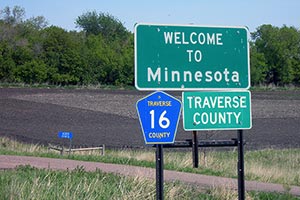Minnesota DOT Recognizes Importance of Freight in Its Highway Program

Freight is now its own category in Minnesota’s highway investment plan for the first time. Spurred by a requirement of the federal FAST Act, Minnesota’s Department of Transportation has allocated $610 million to freight in the $21 billion, 20-year plan.
That’s a bigger piece of the pie than seven of the 14 identified priorities and that’s without a fully realized vision for freight in Minnesota, according to MnDOT’s policy planning director Phillip Schaffner.
“It’s a pretty significant amount considering how little we’re spending outside of maintenance,” said Margaret Donahoe, executive director of the Minnesota Transportation Alliance.
“To some extent, it’s kind of a placeholder,” Schaffner told Transport Topics. “We’re sort of gearing to do a follow-up which would be our freight investment plan. We felt we wanted to take a little bit more time to really look at exactly what we should be doing related to the freight dollars.”
Schaffner added that MnDOT will likely consult with its Freight Advisory Committee – which includes Minnesota Trucking Association CEO John Hausladen – while putting together its more thorough freight investment plan by late 2017.
“We’re very pleased that freight is specifically included in the plan, but view it only as a start,” Hausladen said. “We look forward to working with MnDOT to further flesh out the plan and identify the critical freight connections in Minnesota required to keep freight moving efficiently.”
Schaffner hopes that the freight investment plan will address “the needs of the freight community and their priorities for the system.”
However, with the Legislature having failed to pass a fuel tax hike this year, Minnesota continues to struggle to fund that system.
“The gap between what we think we need to maintain the system and how much money we project to have continues to grow,” Schaffner said. “Our current pavement condition is pretty good, but we are forecasting that it’s going to deteriorate over the next 20 years. We’re increasingly prioritizing maintaining our existing system. We’re doing what we can with our limited flexibility to make the right fixes at the right times, but over time, we’ll likely need to make short-term fixes just to keep the system operating.”
Donahoe noted that MnDOT’s funding gap has grown from $12 billion in the last long-term budget in 2014 to $18 billion.
“We’re continuing to fall further and further behind because the revenue’s not keeping up,” Donahoe said. “After maintaining pavement and bridges, there’s very little left for much of anything else. [MnDOT has] reduced the amount of money going to mobility in the Twin Cities, which is important for truckers. If there was more money, they said their No. 1 priority is more maintenance, which is a concern for us. If we’re going to build the support for more money for the department via tax increases, the legislators are going to want to see results other than more pavement improvements.”

